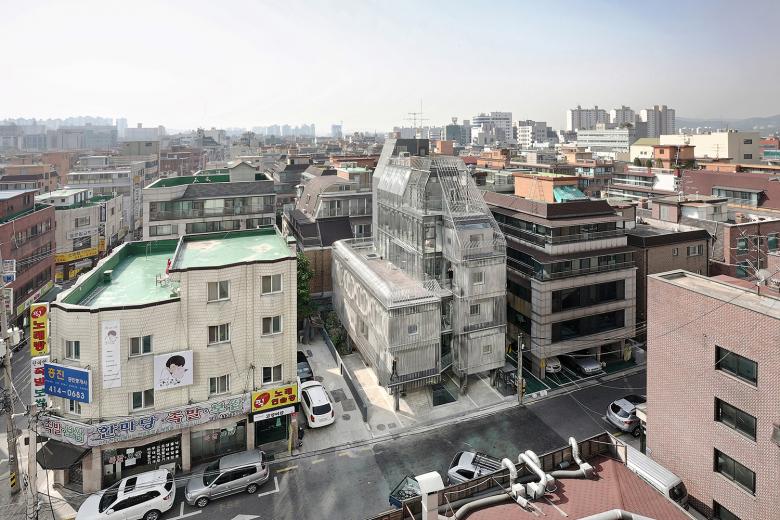Songpa Micro-Housing
"Tapioca Space" is how SsD (Single Speed Design - the firm of Jinhee Park and John Hong) creatively describe the in-between spaces of this Micro-Housing project they realized in Seoul, Korea. In addition to these small spaces that create the potential for shared connections between the residents, the building is uniquely covered in twisted stainless steel that is veers from safety railing to bike rack. SsD answered a few questions about the project that is deservedly getting a lot of attention.
Please provide an overview of the project.
The project is a micro-housing building in Seoul, Korea that reflects our concept of "Micro-Urbanism." Instead of providing minimal subsistence living therefore, relationships between residents, art and retail spaces, and the urban community are formed to create a new kind of fine-grain urbanism. Occupying a small urban infill lot, fourteen units are carefully arranged to create a variety of public, semi-public, and semi-private, and private spaces that can be creatively occupied.
What are the main ideas and inspirations influencing the design of the building?
The problem of urban density and housing costs is global. As unit types get smaller however, land costs coupled with developer driven profit margins can merely create a provisional housing type with little social value. By mining the discrepancy between maximum floor area ratios and maximum zoning envelopes, Songpa Micro-Housing provides a new typology that extends the limits of the housing unit to also include semi-public circulation, balconies, and the thickness of walls. Like the ambiguous gel around a tapioca pearl, this "Tapioca Space" becomes a soft intersection between public/private and interior/exterior, creating social fabrics between neighbors.
How does the building relate to contemporary architectural trends, be it sustainability, technology, etc.?
The building screen/railing is a parametrically developed twisted stainless steel system designed to accommodate a variety of conditions. Firstly it modulates privacy and views through its density and amount of twist as well as acting as a security barrier for lower floors. Secondly, it becomes a safety railing for the project’s many exterior balconies. Thirdly, it functions as building infrastructure by acting as the balcony water drainage system as well as masking key electrical and gas lines must be accessibly exposed according to local codes. Finally it wraps from horizontal to vertical to form awnings and bicycle parking areas. To work within budget constraints, only eight types of twist were arrayed to form what appears to be a more organic configuration.
How did you approach designing for Seoul/Korea and how would you describe the process of working on the project there?
Seoul is a city that is both intensely global and intensely local. Clients and the general public are many times well-versed in design and cultural trends and a collaborative spirit can many times further the design concepts. Materials and techniques, although mostly sourced locally, are influenced by international standards and expectations. On the other hand, Seoul has highly regulated zoning and code constraints that are not only specific to each city, but "micro-specific" to regions of the city. This requires careful navigation of regulatory ordinances and public processes. In terms of the construction process, schedules and field coordination takes on an intensity that is almost wholly unfamiliar in the West and requires daily administration to achieve a high level of execution. This mix between local and global requires deep knowledge for architects practicing in the city.
How would you describe the architecture of Seoul/Korea and how does the building relate to it?
Seoul was mostly destroyed in the Korea War during the 1950s and thus went through an intense period of modernization where the materials of the past were replaced with the concrete, steel, and glass typical of globalized architecture. However, the cultural practices of daily use including fine grain programmatic adjacencies, appreciation of outdoor space and nature, as well as a materiality that references traditional assemblies imbue a potentially generic modern vocabulary with very site specific presence. Thus Korean design has emerged as a new example of regional responsive but internationally influenced form of modernity.
Email interview conducted by John Hill.
Songpa Micro-Housing
2014Seoul, Korea
Client
Chanill Lee
Architect
SsD
New York, NY, USA
Design Principal
Jinhee Park AIA
Project Architect
John Hong AIA
Project Manager
Seunghoon Hyun
Project Team
Taylor Harper, Allison Austin, Evan Cerilli, Mark Pomarico, Yufeng Zheng, Victor Michel, Virginia Fernandez Alonso
Associate Architect
Dyne Architecture
Structural Engineer
Mirae Stuctural Design Group
Lighting Designer
Newlite
Construction Manager
Kiro Construction
Acoustical
RPG Korea
Fabrication
Mohse (metal screen), Madein (built-in furniture), Slyducks (outdoor furniture)
Site Area
2,200 sf
Building Area
5,500 sf
Photographs and Drawings
SsD














